After successful sales at Christie’s and Sotheby’s this week, Phillips Modern and Contemporary Evening Sale on Wednesday (20 November) yielded nearly $54.8m ($67.3m with fees). That’s nearly 25% more than the same sale in November last year.
Out of 33 lots, only two did not sell, for a sell-through rate of 94 percent by lot. Following auction houses like Sotheby’s and Christie’s but a first for Phillips, the fine art sale also included several natural history objects, with mixed results.
“There were very few surprises for me,” Chicago-based art advisor Laura Lester told The Art Newspaper. “I think they did really well with the material that they did have. I think the fact that people were bidding on these things and they were selling for healthy numbers was really encouraging.”
Despite the absence of large estates—like the Lauder collection at Sotheby’s the night before—the evening sale still generated several bidding wars, a new artist record (briefly), and many works selling for more than the house’s high estimates.
The top lot was Francis Bacon’s Study for Head of Isabel Rawsthorne and George Dyer (1967), which hammered at $13.5m ($16m with fees) on a high estimate of $18m. It was followed by an untitled work by Joan Mitchell from 1957-58 which hammered at $12m ($14.3m with fees) against a $15m high estimate.
Cera, the juvenile Triceratops Courtesy Phillips
Early in the evening, a juvenile Triceratops skeleton from the Late Cretaceous period (roughly 66 million years ago) hammered at $4.35m ($5.4m with fees) against a high estimate of $3.5m. Called Cera, the fossil went to a client on the phone with natural history consultant Christian Link after 14 bids between Link; Phillips’ chairman of private sales Meity Heiden; director of private sales Alexander Weinstock; and Scott Nussbaum, the auction house’s deputy chairman for the Americas and senior international specialist for Modern and contemporary Art.
Female artists did well, especially for works that started the sale. Ruth Asawa’s copper wire sculpture Untitled (S.230, Hanging Single-Lobed, Five-Layered Continuous Form within a Form) kicked off the sale with high energy, prompting two dozen bids over more than four minutes to hammer at $780,000 (more than $1million with fees) on a high estimate of $600,000. Another Asawa work, Untitled (S.443, Hanging Single-Lobed, Five-Layered Continuous Form within a Form) also prompted 20 bids over two minutes and sold for $903,000 on a high estimate of $500,000.
Lester said she wasn’t surprised by the results, given the artist’s critically-acclaimed current exhibition at the Museum of Modern Art in New York after the San Francisco Museum of Modern Art, and limited supply in the primary market. “They’re very hard to get and very expensive to get from Zwirner,” Lester said, adding Asawa is “a universally appealing artist”.
The second lot was Olga De Amaral’s 5-foot-long Alquimia 62 (1987) from the estate of Samuel J. and Eleanor T. Rosenfeld, which also prompted 21 bids, hammering at $580,000 or $748,200 with fees, on a high estimate of $500,000.

Firelei Báez’s Daughter of Revolutions (2014) Courtesy Phillips
That momentum continued for the third lot, Firelei Báez’s Daughter of Revolutions (2014), which set a new record for the artist after hammering for $500,000, or $645,000 with fees, on a high estimate of $500,000. It also had a house guarantee and irrevocable bids. However, that record would only last a few hours—Báez’s 2021 painting Untitled (Colonization in America, Visual History Wall Map, Prepared by Civic Education Service) sold for more than $1.1m with fees, at Christie’s 21st Century evening sale on Thursday evening.
An untitled acrylic work on paper by Alma Thomas also sold for $477,300 including fees on a high estimate of $350,000. And an untitled artwork by Martha Jungwirth from 2017 sold for $516,000 with fees on a high estimate of $300,000.
A notable exception to the evening was an untitled painting by Jadé Fadojutimi from 2022, with an estimate of $800,000 to $1.2m. After five bids, it was bought in. The other item that did not sell was The Thunderbolt, the longest gold nugget ever found at nearly 50 centimeters long. The 114.6 troy ounces (3,565 grams) of crystallised precious metal had an estimate of $1.3m to $1.5m, but was bought in after five bids. (Another gold object, Maurizio Cattelan’s America (2016), also failed to capture wide interest, selling for $10m ($12.1m with fees) after one bid to Ripley’s Believe It or Not!)
Lots that exceeded their high estimates included Mark Tansey’s Revelever (2012), Max Ernst’s Dans les rues d’Athènes (1960) and Robert Motherwell’s A Sculptor’s Picture, with Blue (1958), two of which prompted extended bidding wars.
Revelever (2012) hammered at $3.76m ($4.6m with fees) on a high estimate of $3.5m after 24 bids over seven minutes, involving two people in the room and three specialists on the phone, prompting applause at the end; while A Sculptor’s Picture, with Blue (1958) hammered at $950,000 ($1.2m with fees) against a high estimate of $1m.
Max Ernst’s Dans les rues d’Athènes (1960) Courtesy Phillips
The most intense bidding war of the evening was for Dans les rues d’Athènes (1960), which saw in 31 bids over seven minutes between five Phillips staffers competing for their respective clients. Dans les rues d’Athènes hammered at $1.2m ($1.5m with fees), blasting past its high estimate of $600,000. The bronze sculpture came from the family of American artist Dorothea Tanning, and one of the other five editions is in the permanent collection at the Peggy Guggenheim Collection in Venice.
“I’m sure they knew that interest was far outstripping the estimate and it would do well,” Lester says. “I think it goes to show how that historical material that has shown the test of time is safe and there are always buyers for art even in a down market.”
